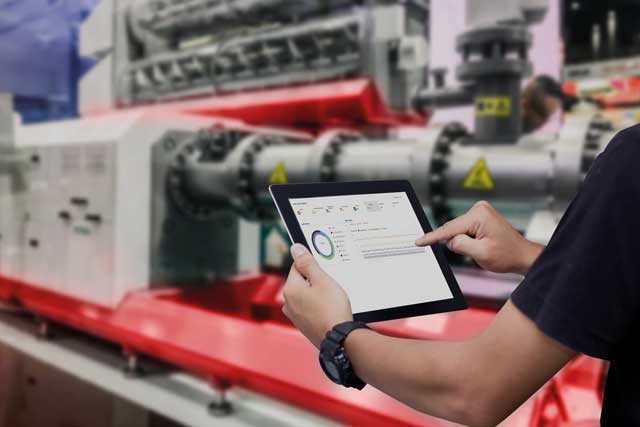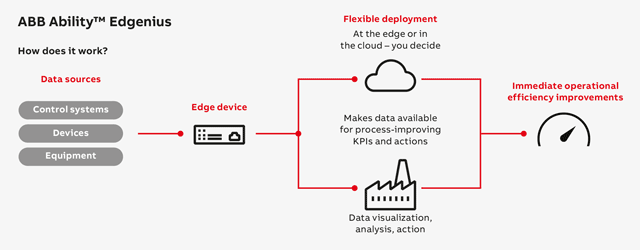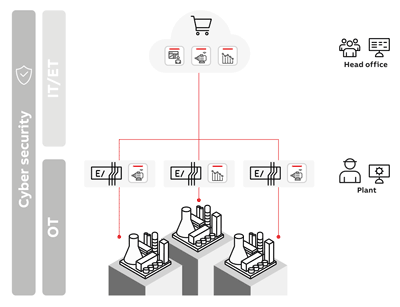
Today’s highly automated factories are faced with management of a wealth of data. Edge computing is transforming the way that data is handled and processed, offering real-time computing power enabling processes to be more intelligent and autonomous. Christian Johansson, global product manager for ABB Ability Edgenius, explains.
Edge computing is a distributed computing model where the operation data processing takes place near the actual location from where data is being collected and analysed, rather than in the Cloud or on a centralised server. Edge computing creates a new kind of approach to the network architecture.
By bringing the computing power nearer to the data source, edge computing provides a range of benefits such as faster processing, a more flexible application deployment and improved security.
The rise in a new generation of automation systems brought about significant efficiency gains throughout industry. The introduction of edge computing continues this trend through consolidation and analysis of data from many different sources, including control systems and smart devices.
Combining the potential of these devices – which collectively form the industrial internet of things – with the processing power of edge computing, automation solutions and analytics ultimately gives companies a new way to realise the full value of their production data.
They make it possible to monitor the primary factory processes and ensure production targets for efficiency and quality are met, while the resulting data helps make sure that equipment and devices are performing within expected parameters.
One of the major benefits of edge computing is that by placing the computing power near the devices generating data, latency is reduced. Latency is the time needed for the request for data to travel from the source to the central point where the data is held, for the request to be processed and the response sent back to the relevant point. Being in situ means that edge computing offers a faster response, making possible real-time control, which in turn optimises performance in real time.
Edge computing can also reduce the reliance on constant connectivity with the cloud, making processes more reliable. An edge computing network contains multiple points of storage and data processing, making networks less susceptible to data loss caused by hardware failure and other causes like cyber attacks.
By minimising the need for high volume data transfer capabilities and high capacity cloud servers, edge computing reduces costs. Data on the network no longer needs to be transmitted over long distances or in large quantities.
Another major advantage of edge computing is its scalability. The ability to add new edge nodes or further measurement devices as needed is a boon for companies that might want to change the scope or scale of their processes in the future. This is made easier if solutions are chosen that allow easy connectivity between devices and the systems that serve them, such as OPC Unified Architecture.
Edge computing is seen by many as an easy way for hackers to gain entry to a plant’s network – yet the very fact that edge computing is distributed offers the opportunity to seal off an affected device or computer from the rest of the system. By managing edge nodes from the cloud, agility in security updates can also be improved. When you choose an edge solution it is essential that the vendor can demonstrate that security extends to all levels, to protect against cyber hacks and prevent unauthorised access.
From the Edge to the Cloud
Before the more mainstream adoption of edge computing, the main option for analysing process and device data was, and remains in many cases, the Cloud. The Cloud is served by data processing facilities based at a remote data centre and provides infinite computing capabilities compared with the space limitations which can come with edge computing.

There is currently much discussion about which provides the greater benefit and whether edge computing will replace the Cloud. The truth is that each has its own area of speciality offering complementary advantages which, when used in conjunction with each other, off er a unique and effective means of achieving optimisation and efficiency.
The Edge offers real-time responses to process time-sensitive data, while the Cloud is more suited to centralised collection and where sophisticated analysis of complex data in high volumes or the analysis of long-term trends is required. For remote locations where there may be little or no connectivity to a central location, edge computing is the natural choice as these locations require local storage.
As well as preparing data for the Cloud, the Edge can also act as the implementer of protocols developed in the Cloud – using the gathered data, the Cloud can determine suitable parameters or operational limits for process devices, downloading these to edge facilities for implementation and monitoring.
Because they are very different technologies, Edge and Cloud cannot really act as replacements for each other, although they are becoming more similar in features and merging some of their capabilities and functions.
In the future, the most successful businesses will be those that adopt an effective site, edge and cloud strategy that can create value by transforming collected data into useful information in real time, and then in a cost-effective manner share it across the enterprise wherever and whenever it is needed.
Edgenius from ABB is an example of cloud and edge computing coming together. The ABB Ability Edgenius platform supports advanced data collection, pre-processing, calculation and analysis. It provides a secure connection between the ABB Ability Cloud, control systems and smart devices. ABB’s flagship distributed control systems, ABB Ability System 800xA and ABB Ability Symphony Plus, provide smart purpose-built Publisher interfaces to stream data to the Edge and Cloud with minimal engineering effort. Other control systems and devices are connected using protocols such as OPC UA and Modbus TCP.
With flexible deployment either at the Edge (on the premises) or in the Cloud, Edgenius enables immediate operational efficiency improvements thanks to quick and easy integration with existing control systems and devices.
Extending automation solutions with edge and cloud applications offering analytics opens new opportunities for improved performance spanning all areas of operation, from production through to fleet management and maintenance. By using the combined power of these technologies to unlock the data from IIoT devices and control systems in their production processes, industrial companies can transform their efficiency and realise the full benefits of Industry 4.0.

Future developments
What does the future hold? Two of the technologies enabling the growth of edge computing are 5G and artificial intelligence. All these three have a symbiotic relationship which will be potentially transformative for industry.
The deployment of extensive 5G networks with widespread connectivity will aid rapid data exchange. In particular, the ability of 5G networks to provide “network slices”, virtual private networks for the exclusive use of one company, will ensure rapid, secure transfer among industrial sites.
AI is also growing more powerful and compact, allowing highly capable analytical abilities to get close to the sources of data and providing intelligent decision making in real time. AI requires the extremely fast processing of data provided by edge computing; in turn AI enables higher performance of computer resources and intelligence at the Edge.
Anna Mourieras
anna.mourieras@fr.abb.com | +33 674406158

